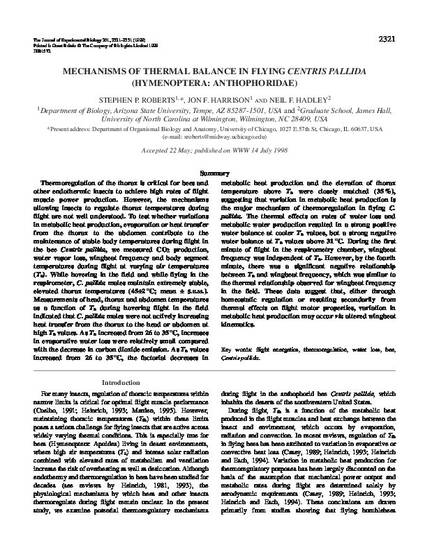
Thermoregulation of the Thorax is Critical for Bees and Other Endothermic Insects to Achieve High Rates of Flight Muscle Power Production. However, the Mechanisms Allowing Insects to Regulate Thorax Temperatures during Flight Are Not Well Understood. to Test Whether Variations in Metabolic Heat Production, Evaporation or Heat Transfer from the Thorax to the Abdomen Contribute to the Maintenance of Stable Body Temperatures during Flight in the Bee Centris Pallida, We Measured CO2 Production, Water Vapor Loss, Wingbeat Frequency and Body Segment Temperatures during Flight at Varying Air Temperatures (T(A)). While Hovering in the Field and While Flying in the Respirometer, C. Pallida Males Maintain Extremely Stable, Elevated Thorax Temperatures (45±2°C; Mean ± S.E.M.). Measurements of Head, Thorax and Abdomen Temperatures as a Function of T(A) during Hovering Flight in the Field Indicated that C. Pallida Males Were Not Actively Increasing Heat Transfer from the Thorax to the Head or Abdomen at High T(A) Values. as T(A) Increased from 26 to 35 °C, Increases in Evaporative Water Loss Were Relatively Small Compared with the Decrease in Carbon Dioxide Emission. as T(A) Values Increased from 26 to 35°C, the Factorial Decreases in Metabolic Heat Production and the Elevation of Thorax Temperature above T(A) Were Closely Matched (35%), Suggesting that Variation in Metabolic Heat Production is the Major Mechanism of Thermoregulation in Flying C. Pallida. the Thermal Effects on Rates of Water Loss and Metabolic Water Production Resulted in a Strong Positive Water Balance at Cooler T(A) Values, but a Strong Negative Water Balance at T(A) Values above 31 °C. during the First Minute of Flight in the Respirometry Chamber, Wingbeat Frequency Was Independent of T(A). However, by the Fourth Minute, There Was a Significant Negative Relationship between T(A) and Wingbeat Frequency, Which Was Similar to the Thermal Relationship Observed for Wingbeat Frequency in the Field. These Data Suggest that, either through Homeostatic Regulation or Resulting Secondarily from Thermal Effects on Flight Motor Properties, Variation in Metabolic Heat Production May Occur Via Altered Wingbeat Kinematics.
- Bee,
- Centris pallida,
- Flight energetics,
- Thermoregulation,
- Water loss
Available at: http://works.bepress.com/stephen-roberts/34/
